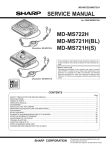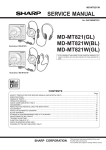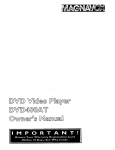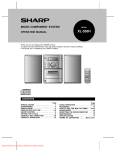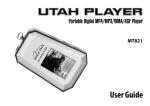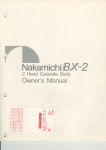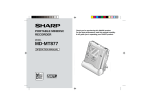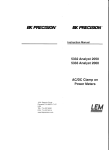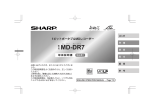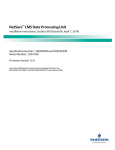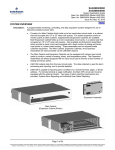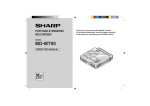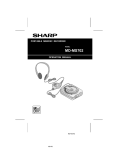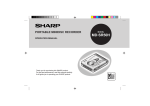Download Sharp MD-MT821H Specifications
Transcript
Page ACCESSORIES . . . . . . . . . . . . . . . . . . . . . . . . . . . . . . . . . . . . 1 SPECIAL NOTES . . . . . . . . . . . . . . . . . . . . . . . . . . . . . . . . . 2 PRECAUTIONS . . . . . . . . . . . . . . . . . . . . . . . . . . . . . . . . . 3-4 NAMES OF CONTROLS AND INDICATORS . . . . . . . . . . . . . . . . . . . . . . . . . . . . . . . . . 4-5 POWER SOURCE . . . . . . . . . . . . . . . . . . . . . . . . . . . . . 6-7 BEFORE RECORDING . . . . . . . . . . . . . . . . . . . . . 8-9 RECORDING USING THE ANALOG CABLE . . . . . . . . . . . . . . . . . . . . . . . . . . . . . . . . . . . . . . . 10-11 RECORDING USING THE OPTICAL DIGITAL CABLE . . . . . . . . . . . . . . . . . . . . . . . . . . . . . 12 RECORDING FROM THE MICROPHONE . . . . . . . . . . . . . . . . . . . . . . . . . . 13-14 CONVENIENT RECORDING FUNCTION . . . . . . . . . . . . . . . . . . . . . . . . . . . . . . . . . 15-18 Page ABOUT TRACK NUMBERS .............. 19 ABOUT THE TOC.. ............................. 20 PLAYING A MiniDisc C ................... 21-22 CONVENIENT PLAYBACK FUNCTIONS .............................. 23-25 EDITING ........................................ 26-31 USING WITH OTHER EQUIPMENT . . 32 CONVENIENT OPERATION OF THE UNIT ........................................... 33-35 WHAT IS A MINIDISC? ...................... 36 TROUBLESHOOTING .................. 36-37 MINIDISC SYSTEM LIMITATIONS.. ... 38 ERROR MESSAGES.. ........................ 39 MAINTENANCE ................................. 40 SPECIFICATIONS ......................... 40-41 0 Remote Control Unit x 1 0 Battery Case (GCASZ0086AFSA) x 1 (RRMCW0043AFSD) 0 Analog Cable (QCNWG0382AFZZ) x 1 0 Optical Digital Cable x 1 0 Headphones (RPHOH0185AFZZ) x 1 0 AC Adaptor (RADPA3489AFZZ) x 1 (QCNWG0422AFZZ) 0 Rechargeable Lithium-Ion Battery 0 Carrying Bag (UBAGCOO83AFSA) x 1 (AD-T51 BT) x 1 0 Handstrap (UBNDT0086AFSA) x 1 (UBATl0088AFSA) Note: Parts and equipment mentioned in this operation manual other than those detailed above are not included. For optional accessories, contact your local dealer, call the Sharp Accesories and Supply Center at l-800-642-2122, or visit SHARP’s web site (http:/’ www.sharp-usa.com). W How to attach the handstrap 0 Contains Lithium-ion Battery. Must be Disposed of properly. Contact Local Environmental Officials for disposal instructions. US and foreign patents licensed from Dolby Laboratories Licensing Corporation. The letters in brackets contained in the model number indicate the color of the product only. Operation and specifications are unaffected. 0 It is the intent of Sharp that this product be used in full compliance with the copyright laws of the United States and that prior permission be obtained from copyright owners whenever necessary. Caution -- use of controls or adjust- herein may result in hazardous FOR YOUR RECORDS For your assistance in reporting this unit in case of loss or theft, please record below the model number and serial number which are located on the bottom of the unit. Please retain this information. Model number Serial number Date of purchase Place of purchase Note: This equipment has been tested and found to comply with the limits for a Class B digital device, pursuant to Part 15 of the FCC Rules. These limits are designed to provide reasonable protection against harmful interference in a residential installation. This equipment generates, uses, and can radiate radio frequency energy and, if not installed and used in accordance with the instructions, may cause harmful interference to radio communications. However, there is no guarantee that interference will not occur in a particular installation. If this equipment does cause harmful interference to radio or television reception, which can be determined by turning the equipment off and on, the user is encouraged to try to correct the interference by one or more of the following measures: Reorient or relocate the receiving antenna. Increase the separation between the equipment and receiver. Connect the equipment into an outlet on a circuit different from that to which the receiver is connected. Consult the dealer or an experienced radio/TV technician for help. WARNING FCC Regulations state that any unauthorized changes or modifications to this equipment not expressly approved by the manufacturer could void the user’s authority to operate this equipment. 2 4 l - I 0 n Storing the unit W lmportant Avoid using or leaving the unit in the following places. Do not wear your headphones when you are crossing streets or near traffic. Do not use your headphones while driving a motor vehicle, it may create a dangerous traffic hazard and may be illegal. Remember to obey all of the safety rules in your area. Do not play the unit at a high volume. Hearing experts advise against extended listening at high volume levels. If you experience ringing in your ears, reduce the volume or discontinue use. Places exposed to direct sunlight for many hours (especially in cars with the doors and windows closed) or near heaters. (The cabinet may deform, change color or malfunction.) Places exposed to water. Places exposed to excessive dust. Places where temperatures are excessively high or low. Places (bathrooms) where the humidity is extremely high. Places with strong magnetic fields such as TVs or loudspeakers. Places exposed to vibration. 0 Places where sand can easily enter the ‘inside of the unit (beaches etc.). 0 If the unit is used near radio tuners or TVs, noise and/or picture interference may result. If you experience these problems, move the unit away from such devices. W Volume setting If the volume is adjusted according to your usual expectations of noise, you may damage your hearing due to the high volume. Reduce the volume before starting to play. MiniDiscs, compared to ordinary cassette tapes, have very little noise. n Concern for others when listening to MiniDiscs n Precautions While listening to music, the sound escaping from your headphones may annoy people around you. If you are using the unit in particularly crowded places (such as on trains or buses), reduce the volume to avoid disturbing people around you. To avoid accidental electric shock or other possible problems, observe the precautions listed below. Do not disassemble or modify the unit. Do not drop or subject the unit to shock. Do not use the unit near open flames. Do not spill liquid on the unit. Do not use an external power supply, other than the 5V DC power supply packaged unit. SHARP is not responsible for damage due to improper use. Refer all servicing to a SHARP authorized service center. 3 Notes about the rechargeable batterv A rechargeable lithium-ion battery is the only kind that can be used. Even if the battery supplied with the unit is not used, you should charge it at least once every three months to maintain the battery. The rechargeable battery can be charged approximately 300 times. Do not use any battery other than that specified. Use of other batteries may cause malfunctions. When the operating time is reduced to about half the normal amount of time, even after a full charge is performed, replace the battery with a new one. When charging or when using the re chargeable battery, use it within an ambient temperature range of 41 “F(5”C) to 95”F(35”C). If the rechargeable battery is used in a cold environment, the operating time will be reduced. Since the rechargeable battery is vulnerable to damage, please note the following. Do not carry the battery in your pocket or a bag together with metal objects (keys, coins, jewelry, etc.). The battery may short out and generate significant amounts of heat. Do not short-circuit the terminals as they will become very hot and will damage the battery. Do not dip the battery in water, do not dispose of it in a fire, and do not take it apart. To avoid damaging the battery and shortening its service life, please note the followina. Do not drop or subject the battery to shock. Do not insert objects (metal etc.) into the battery compartment of this product or into the rechargeable battery. Do not get the terminals dirty. If the rechargeable terminals are dirty, the operating time may be shortened or it may not be possible to charge the battery. After the rechargeable battery is charged or used, it will get slightly warm. This is normal. W Remote control unit 1. Synchro Recording Indicator 2. Character/Time Information Indicator 3. Record Indicator 4. Repeat Indicator 5. Random Indicator 6. Disc Mode Indicator 7. Total Track Number Indicator 8. Track Number Indicator 9. Battery Indicator 10. Headphones Jack 11. Display/Volume Shuttle Switch 12. Hold Switch 13. Play/Pause/Fast Reverse/ Fast Forward Shuttle Switch 14. Stop/Power Off/Bass/Play Mode Shuttle Switch W Main unit 1. Monaural Long-Play Mode Indicator 2. Record Indicator 3. Level Meter 4. Repeat Indicator 5. TOC Indicator 6. Battery Indicator 7. Random Indicator 8. Track Number Indicator 9. Character/Time Information Indicator 10. Synchro Recording Indicator 11. Disc Mode Indicator 12. Disc Name Indicator 13. Track Name Indicator 14. Remaining Recording Time Indicator 15. Total Track Number Indicator 16 17 18 19 h 16. Record/Track Mark Button 17. Mode Button 18. Bass/Delete Button 19. Enter/Fast Play/Synchro Button 20. Volume/Cursor Up Button 21. Volume/Cursor Down Button 22. Edit/Auto Mark/Time Mark Button 23. Display/Character Select button 24. Fast Reverse/Fast Forward/Recording Level Control/Name Select Shuttle Switch 25. Stop/Power Off Button 26. Play/Pause Button 20 21 27. Open Lever 28. Headphones Jack 29. Optical/Line Input Jack 30. Handstrap Holder 31. Hold Switch 32. Battery Case Connection Terminals 33. Microphone Input Jack 34. 5v DC Input Jack 35. Rechargeable Lithium-Ion Battery Compartment 5 This unit can be used with 4 different power sources: a rechargeable battery, an AC adaptor, a battery case, and a separately available car adaptor (AD-CA20X). n Rechargeable battery power When the rechargeable battery IS used for the first time or when you want to use it after a long period of non use, be sure to charge it fully. 1 Open the rechargeable battery compartment cover. 2 Insert the rechargeable battery. 0 Insert the side with the arrow first. 2 3 Close the rechargeable battery compart- Mark ment cover. 4 To the DC IN 5V jack Insert securely, all the way In. Plug the AC adaptor into the AC outlet, and then insert the plug on the AC adaptor cord into the DC IN 5V jack. 0 About 4 seconds later, " B " will flash, and the battery will begin charging. l Battery charging will be complete in 3.0 hours. When the charging IS complete, " B " w i l l go out. AC 12OV, 60 Hz To an AC outlet Notes: 0 After charging has been completed, the AC adaptor may be left connected. (For example, when charging at night) 0 If the rechargeable battery is in the unit, it will be charged, even while operating the unit. (Float charge) 0 0 6 Do not force open the rechargeable battery cover too far. When the AC adaptor plug is inserted and a MiniDisc has already been inserted, playback may start automatically. In this case, press the n / :OFF button twice to turn the power off. W Alkaline battery power If you use the battery case and the rechargeable battery at the same time, the MD can play much longer than with only one battery power source. 0 Use one commercially available alkaline battery (LR6, “AA” size). 1 3 d- Backof the MD recorder 2 Make sure that a fully charged rechargeable battery is inserted. 0 Do not use the unit if it only has an alkaline battery in it. Insert the battery into the battery case. (1) Open the case cover. (2) Insert the battery according to the polarity marked on the inside of the battery case. Then, close the case cover. 3 Attach the battery case to the main unit. (1) Match the bumps on the battery case to the holes in the main unit. (2) Turn the screw in the direction marked “LOCK” to secure the battery case. While you are using the rechargeable battery and the alkaline battery at the same time, do not remove either of them. If you do, while the unit is in the play mode, playback will stop. When in the recording mode, the recorded contents will be erased, and the power may be disconnected. Do not use rechargeable batteries (nickel-cadmium battery etc.) in the battery case. If the unit will not be used for a long period of time, remove the battery. (Even if the power is turned off, the battery will drain slowly but continuously.) Be sure to hold the plug when removing it. If you pull on the cord, it may break, or the unit may malfunction. Do not use any car adaptor except for the separately available AD-CA20X. For information about the battery life, see the battery section in the SPECIFICATIONS on page 40. This unit should only be used within the range of 32”F(O”C) and 104”F(40°C). W AC power 1 Connect the cord from the AC adaptor to the DC IN 5V jack on the main unit. 2 Plug the AC adaptor into an AC outlet. Notes: 0 When there is thunder or lightning in your vicinity, unplug the AC adaptor from the AC outlet. 0 When the unit is not in use for extended periods, remove the AC adaptor from the AC outlet. 0 Never use an AC adaptor other than the one specified. Otherwise, problems or serious hazards may be created. 0 Do not bend, twist or tie the power cord or put heavy objects on top of it. 7 : 0’ ; 0-m n Type of recording Two types of recording are possible: “Digital recording” and “Analog recording”. There are different cables and connections for each type of recording, depending on the jacks on the equipment being connected to the unit. (1) Analog recording Connect the unit to equipment that has a line output jack, using the analog cable i n cluded with this unit. 0 Main equipment: CD player, MD player, radio cassette player, etc. 0 Cable required: Analog cable included with this unit (2) Digital recording Connect the unit to equipment that has an optical output jack using the optical digital cable included with this unit. Usinq an optical signal to transfer the music to a Minidisc allows very high quality recording. 0 Main equipment: CD player, MD player, DSS tuner, etc. 0 Cable required: Optical digital cable included with the unit. To the line output jacks on a stereo Optical digital cable included with this unit I Playback side To the optical output jack (square shaped jack) on a stereo etc. W Types of discs There are two types of discs: playback-only and recordable discs. 0 Recordable MiniDisc: 0 Playback-only MiniDisc: This type of MiniDisc usually contains commercially available pre-recorded music. This is the same kind of optical disc as CDs. Playback is performed using an optical pickup. (Recording and editing are not possible.) + 10I This is a “raw disc” on which recording can be performed. This is a magnetooptical disc. Recordings are made using a laser and a modulated magnetic field. Repeated recording is possible. Shutters can be seen on both sides of this type of disc. There will only be a shutter on one side (the back). H To prevent recorded discs from being erased accidentally Slide the accidental erase prevention tab, located on the side of the disc, in the direction indicated bv the arrow. 0 The disc will then be protected against accidental erasure. 0 To add a recording to such a disc, slide the accidental erase prevention tab back to its original position. Protected against accidental erasure Notes: consumption will be less than when listening to the recording while it is being made. 0 Insert each plug firmly. If the connections are poor, the recording may not be made properly. Always keep the plugs clean. If the plugs are dirty, electrical noise may be recorded. 0 When making important recordings, it is recommended that you use the AC adaptor. A fully charged rechargeable battery should be loaded into the unit. Then, even if a power failure occurs, the power source will switch over to the rechargeable battery automatically. 0 When using the rechargeable battery or the alkaline battery, if the headphones volume level is set to “o”, the battery 9 n Recording from CDs or MDs (Synchro recording) 0 Svnchro recording is a method that detects the playback sound from the source equipment. When sound is present, it automatically s t a r t s recording. When the sour&is silent, the recordina will be paused 0 Adjust the recording level so that the maximum sound volume from the source makes the reading swing somewhere between -4 dB and 0 dB. 0 To record from a CD, first adjust the recording level. Then put the equipment connected to this unit into the playback stand-by mode. 1. 5 Press the ENTER/SYNC button. connect the external equipment. (See page 8.) . Insert a recordable MiniDisc. 0 6 Begin playback on the source equipment. 0 Recording will begin automatically. To interrupt recording: When the source equipment is stopped, the unit will enter the synchro recording stand-by mode. When playback is resumed, a recording will be resumed. If a silence lasts for 3 seconds or more, the recording will be paused. Pressing the HI button on this unit (when in this mode) will cause the unit to enter the recording stand-by mode and cancel the synchro recording mode. 3 Press the REC button. 0 To record from a tuner, first tune in a broadcast. 0 To record from a CD, first start playing the track you want to record. To stop recording: Press the U:OFF button. 0 If the unit is left unattended after the recording is complete, the power will automatically shut off in approximately 2 minutes. 4 While playing sound from the external equipment connected to this unit, move the H1 REC LEVEL H shuttle switch to adjust the recording level. OdB -4dB 10 W Recording from a tuner or a CD (Manual recording) After recording: Press the n /:OFF button while in the stop mode. 0 After the track number has been written on the disc, the power will shut off automatically. (For details about the TOC, see page 20.) 0 Manual recordings can be started and stopped as you like. 1 To remove the MiniDisc: Turn off the power and move the OPEN lever in the direction indicated by the arrow. Place the unit in the recording stand-by mode. (Perform steps 1 -- 4 in the “Synchro recording” section.) 2 Press the )I1 button. 0 Recording will start. 0 To record from a CD, press the )I1 button, and then start playback on the equipment connected to this unit. 0 Track numbers can be created while recording. (Page 17) To interrupt recording: Press the )II button while recording. 0 The unit will enter the recording standby mode. 0 To resume recording, press the HI button again. The track number will be increased by one each time you interrupt a recording. 0 Recordings can not be made in the following situations: B Recording on a playback-only MiniDisc (commercially available music) D If a MiniDisc is protected against accidental erasure (page 9) 0 Depending on the strength and type 01 playback signal in the original recording, the new recording may not begin or pause at the correct point when in the synchro mode. If this happens, try making a manual recording. about the recording level: B If the recording level is too low, the playback sound volume may be too low to hear well. If it is too high, the playback sound may be greatly distorted. Since digitally recorded CDs have a large dynamic range (the volume can vary tremendously from very soft to extremely loud), do not set the recording level any higher than is necessary. Precautions when inserting a MiniDisc: 0 To insert a MiniDisc, push on the middle of the edge of the disc while holding it parallel to the main unit. 0 If any resistance is felt, do not try to force the MiniDisc into the unit. It may additional more problems. If resistance is felt, remove the MiniDisc and try reloading it. Notes: l Whenever any button is pressed, the Precautions when recording: B Do not jar or bump the main unit while recording. Otherwise, the recording may be unusable. remote control display will light for ap proximately 7 seconds. 0 The REC button does not light. 11 This is the method used for recording digital signals from CDs or MDs exactly as they are stored on the original. Compared to recordings made from analog inputs, digital recordings have extremely high-quality sound. 1 Connect the external equipment. (See page 8.) There are cases where digital recording may be impossible. Synchro recording: Page 10 In the following cases digital recording is impossible, even if you are using digital cables. When you attempt to make a new digital recording from a track that was digitally recorded on a MiniDisc. 0 MiniDiscs are designed so that only first generation digital copies can be made. Further digital copies are prevented by the SCMS (Serial Copy Management System). perform the following steps on the equipment connected to this unit. (1) First, put it in the playback mode. (2) Next, put it in the pause mode. (3) Finally, position it at the beginning (1) Insert a recordable MiniDisc, and then press the REC button. (2) Press the ENTER/SYNC button. (3) Start the playback on the equipment connected to this unit. fFGj%aq Digital cable -1 E=5 CD player, MD Manual recording: Page 11 (1) Insert a recordable MiniDisc, and then press the REC button. (2) Press the )[I button. Digitally recorded MiniDisc 0 When recording from digital inputs,it is not necessary to adjust the recording level. lPlaybackl Digital cable Analog recording is possible. m 1 Notes: 0 This unit incorporates a sampling rate converter. When this unit is connected to digital equipment such as a DSS tuner or DAT tape recorder that use a different sampling frequency (32 kHz or 48 kHz), recordings can still be made. (The sampling frequency of this unit is 44.1 kHz.) 0 When making a digital recording from a portable CD player (if the player has a sound skip prevention function and this function is turned on) the optical output will drop out and digital recording will not be possible. Be sure to turn the sound skip prevention function off. 1 2 n Recording from the microphone (Mic synchro recording) The recording will begin automatically in response to a noise or a person speaking. When the sound stops, the recording will pause. This function is convenient when recording lectures, conferences, etc. Stereo microphone (commercially available) To the MIC IN jack 1 5 Press the ENTER/SYNC button to se- Connect the stereo microphone to the MIC IN jack on the main unit. 0 When a microphone is connected to this unit, the unit will automatically switch to input from the microphone. lect the synchro recording level. (This level can be changed, even while recording.) 0 Refer to the following table. 2 Insert a recordable MiniDisc. I I (See page 10.) 3 Press the REC button. Synchro recording level display Sound level at which to start recording 0 A monaural, long-play recording mode is available. (Page 17) 0 Timed identification marks can be created while recording. (Page 15) 4 Move the t++ REC LEVEL w shuttle 0 When the microphone input is set to “MIC SYNC H”, recording will start when the smallest noise is detected. If the unit starts recording too often from small unwanted noises, set the microphone input to “MIC SYNC L”. switch to adjust the recording level. OdB -4dB 0 Adjust the recording level so that the maximum sound volume from the source makes the reading swing between -4 dB and 0 dB. 0 When the recording level display is changed from “MIC H 21” to “MIC L 20”, the sound will be interrupted momentarily. This is normal. 13 6 When a sound, such as a person speak- W Recording from the microphone (Mic manual recording) ing, is picked up by the microphone, recording will begin automatically. 0 If a silence lasts for 3 seconds or more, the recording will be paused automatically. However, the unit will not pause for about the first 10 seconds after recording has started. 0 You can start recording manually (anytime you like). 1 2 To interrupt a synchro recording: Press the ,I1 button while recording. 0 The Mic synchro recording mode will be canceled, and the unit will enter the recording stand-by mode. 0 To resume synchro recording, press the ENTER/SYNC button again. Put the unit in the recording stand-by mode. (Perform steps 1 -- 4 in the “Mic synchro recording” section.) Press the ,I! button. 0 Recording will start. To interrupt a recording: Press the ,I1 button while recording. 0 The unit will enter the recording standby mode. 0 To resume recording, press the )!I button again. The track number will be increased by one each time you interrupt a recording. To stop recording: Press the U:OFF button. To stop recording: Press the U:OFF button. Notes: 0 If you want to use a microphone, be sure it is a plug-in-power type microphone. l When a plug-in-powertype microphone is plugged in, the main unit will provide power for the microphone’s operation. l If a different type of microphone is plugged in, it may not operate properly or it may cause the unit to malfunction. 0 Insert the plug firmly. If you don’t, the recording will not be made properly. 0 Use a microphone with a 1/8”(3.5 mm) diameter stereo mini plug. 0 While making a mic recording, do not connect anything to the LINE IN jack on the main unit. 14 u Creating marks while making a mic recording (Timed auto mark function) Marks can be created at a fixed interval (every 5 minutes is the default setting) so that the beginning of any track can be found. The interval at which marks are created can be changed by the user. About the timed auto mark: Whenever a recording begins, a track number will be created automatically. 0 - : Track number which is created when a silence lasts for 3 seconds or more during synchro recording. 0 - - - : Track number which is created bv the timed auto mark function. While in the recording stand-by mode or while recording, press the EDIT button. Each time the button is pressed, the setting will change as follows: Example when the setting is for “5 minutes”: 1 When making a mic synchro recording 1 Track Track Track number 2 number 3 number 4 Track number 1 I I. (A mark is created every 5 minutes.) I :. Track number 5 > A A 1 If a silence lasts for 3 seconds or more, a timed auto mark will be created 5 minutes after the previously created track number.. 1 When making a mic manual recording Track number 2 Track number 1 , ! (A mark is created every 10 minutes.) Track number 4 t I I I I I 5 minutes 0 Track number 3 5 minutes 5 minutes A timed auto mark will be created every 5 minutes. When the timed auto mark setting has beenchanged The time between marks may vary slightly when compared with the actual recording time. Track number 1 3 Track number 2 II ,I minutes 10 minutes 10 minutes When the setting is changed to 10 minutes while recording, a timed auto mark will be created 10 minutes after [ the change is made. 15 n To start recording from the middle of an existing track You can erase a portion of a track that has been already recorded and make a new recording. Warning: 0 All of the tracks that follow the newly ren Recording tracks as a single track 1 You can record several pieces of music as a single track, disable the auto marker function. 1 corded track will be erased. During playback, press the )II button at the point where you want to begin rerecording. 2 Press the REC button. 0 To cancel the operation, press the U:OFF button. Press the EDIT button while the recording is paused. 3 Press the ENTER/SYNC button. 0 All of the tracks and track names will be erased, following the point where the playback is paused. (The display will be blanked out immediately.) 2 Press the )II button. 0 Recording will start. Number of the track to be recorded next Note: 0 When making digital recordings using a CD player or an MD player, track numbers will be created automatically regardless of the setting of the auto marker function. 4 Press the )I1 button. 0 Recording will start. Note: 0 When there is a track that you don’t want to erase after the point on the disc where you want to make a new recording, use the move function to move the track and then make your recording after that point. (See “EDITING”, page 26.) Making a track number automatically: Press the EDIT button while the recording is paused. 0 “AUTO MARK” will be displayed. 16 W To check the remaining disc time W Double time recording in monaural mode While recording, you can check the remaining time available on the disc. When recording in the monaural long-play mode, it can be about twice as long as the recording time available for a stereo recording. The monaural long-play mode is very useful for recording conferences or lectures. Press the DISP button while recording or while in the recording pause mode. Press the MODE button while the recording is paused. 0 Each time this button is pressed, the display will switch between the stereo mode and the monaural long-play mode. Remaining recordable time tights up while in the monaural long-play mode. I 0 When the DISP button is pressed again, the unit will return to the initial display. Note: 0 The display of the remaining disc time may vary slightly from the actual remaining time. (Page 38) Notes: If input is from a stereo source, the sounds from the left and right channels will be combined. Although the monitor sound you hear in the headphones while recording is in stereo, recording will be monaural. MiniDiscs recorded in the monaural long-play mode may not play on other MD players. When a recording is made in the monaural long-play mode, you will be able to play back the MiniDisc twice as fast as the normal playback speed. (Page 24) When the unit is stopped after a recording has been made in the monaural longplay mode, the recording mode will return to the stereo mode automatically. n To create your own track numbers while recording You can create your own track numbers at special points in a recording, so that these points can easily be found later. At any point where you want to create a track number while recording, press the REC button (Remote control : move the shuttle switch to BASS). 0 The track number will be written on the disc and the recording will continue uninterrupted. 17 To erase all of the tracks at once: R To erase tracks 1 While in the stop mode, press the EDIT button to select “ALL ERASE”. 0 “ALL ERASE” can also be selected by holding down the EDIT button for at least 2 seconds. 2 Press the ENTER/SYNC button. 0 To cancel the operation, press the B/:OFF button. To erase tracks one at a time: 1 Start playing the track you want to erase, and press the )I1 button. 0 The unit will enter the pause mode. 2 Press the EDIT button to select 3 “ERASE”. Press the ENTER/SYNC button again. 0 All of the track numbers, track names, and disc names will be erased. Number of the paused track 3 Press the ENTER/SYNC button. Notes: 0 Once a track has been erased, it cannot be recovered. Double-check the track number before erasing it. 0 When a track is erased, the numbers assigned to the tracks following the erased track will be automatically decreased by one. 0 When a track is erased, the track name will be erased at the same time. 0 To cancel the operation, press the B/:OFF button. 4 Press the ENTER/SYNC button again. 0 The track will be erased. 5 To erase other tracks, repeat steps 1 4. 18 When recording, track numbers will be created automatically. (Auto marker function/Synchro marker function) When recording from digital inputs: (CDs/MiniDiscs only) When recording from analog inputs: (Including digital inputs other than CDs or MiniDiscs) Track numbers will be created automatically for each track at the same point where track numbers already exist on the CD or MiniDisc. (Synchro marker function) A new track number will automatically be created whenever 1 second or more of silence occurs in the source. (Auto marker function) First track I;f;back ] 1 TrackA First track Track A Second track Third track 1 Track B 1 TrackC) Second track Third track Track B Track C The track numbers on the playbackside may not match the track numbers recorded on the MiniDisc. When recording, if a programed playback is performed by the source or playback is performed by selecting tracks manually, the MiniDisc track numbers may not be the same as on the source. The track numbers can also be changed after recording. Track numbers may not be created, even when recording from digital inputs, depending on the CD player used for the source. If there is some noise in the “silent” spaces from the source, the track numbers may not be created at the correct position, depending on the contents of the source being recorded. You can also record a series of tracks without using the auto marker function. 19 The TOC (an abbreviation for Table of Contents) is information about the track numbers and recorded areas that allow the unit to find musical selections or sounds. The entire MD is controlled by the information in this TOC, which enables the unit to find the beginning of a track quickly or to record automatically in a vacant area. 0 The TOC is recorded in a specific area on a MiniDisc. which is not used for sound recording. W About TOC recording w When is the TOC recorded? When you start recording or editing, "TOC" will appear in the display. The revised TOC will be recorded on the disc automatically when you press the U:OFF button while in the stop mode. this will also turn the power to this unit off. This indicates that information in the TOC is now being changed according to recording or editing being performed. 0 The changed TOC information will not be recorded on the MiniDisc right away. The power will be turned off after the TOC has been recorded on the disc. Notes: 0 While “TOC” is displayed, the MiniDisc should not be removed. Turn the power off first, and then remove the MiniDisc. 0 The edited contents can be stored on the disc after several editing steps have been performed. Caution: While “TOC” or “TOC EDIT!” is displayed, do not do any of the following. - Do not jar or bump the main unit. - Do not unplug the AC adaptor. - Do not remove the rechargeable battery or battery case. If you do, the changes in the recorded or edited contents will be lost if the TOC information is not recorded properly. If the AC adaptor is unplugged or a power failure occurs while recording (before the TOC information has been written on the disc), the new recording will be erased. When a new recording is added to a MiniDisc in a position where TOC infor mation already exists, the added recording will be erased. 20 To interrupt playback: To remove the MiniDisc: Press the )II button during playback. 0 To resume playback, press the )I1 button again. Turn off the power and move the OPEN lever in the direction indicated by the arrow. Resume auto play function: 0 When you press the n /:OFF button to To stop playback: Press the n /:OFF button. stop playback, or when you turn the power off and then you resume playback, it will resume at the point on the MiniDisc where the playback was halted. 0 If the MiniDisc is removed and inserted, and playback is resumed, playback will start from the first track. To turn off the power: Press the n /:OFF button while in the stop mode. 0 If the unit is not operated for at least 2 minutes while in the stop mode. the power will shut off automatically. Precautions when making connections: Caution: 0 When the unit is not to be used imme- 0 Do not use any remote control unit, except for the one included with this unit. 0 Do not remove the rubber pads from the headphones. 0 Insert each plug securely, all the way in. 0 Be sure to hold the plug when removing it. If you pull on the cord, it may break, or the unit may malfunction. diately after a MiniDisc has been inserted, or when you plan to carry the unit, turn off the power or cancel the auto-play function. Otherwise, the auto-play function will be activated and the battery will run down. 0 Since the main unit and the AC adaptor can heat up during use, you should avoid allowing the unit to be in direct contact with your skin for any length of time. Interrupted sound: 0 This product is designed to eliminate interruptions in the sound which can be caused by vibrations. However, if the unit is continuously exposed to vibrations or mechanical shock, the sound may be interrupted momentarily. When the sound is distorted: 0 If the volume is too high while the bass is being emphasized, the sound may be distorted, depending on the music on the track. If this happens, decrease the bass level or lower the volume level. 0 If the volume is increased to “VOL 24 or higher, the bass level will be adjusted automatically. (This is done to reduce the distortion in the sound.) When using the unit with a car adaptor: 0 When you switch off the ignition key during playback, the power to this unit will also be turned off. Then, when the ignition key is switched on, playback will star-l from the beginning of the track where playback was halted (Resume auto-play function). However, the power to the unit may not be turned off when the ignition is turned off, depending on the type of car. , 22 H Cue and review 1 Load a MiniDisc and begin playback. 2 Move and hold the shuttle switch at H for audible fast forward, or move and hold the shuttle switch at H1 for audible fast reverse. 3 Normal playback will resume when the n APSS (Auto Proaram Search system shuttle switch (HI or m) is released. Notes: When the end of the last track is reached during fast forward, the unit will enter the pause mode. When the beginning of the first track is reached during fast reverse, the unit will enter the playback mode. When the unit is in the all track repeat mode, the search will wrap around from the last track to the first, or vice versa. Depending on the contents recorded on a MiniDisc, some sounds may be skipped while cueing and reviewing. APSS automatically locates the beginning of any track. To move to the beginning of the next track: Move the shuttle switch tom during playback. To re-start the track being played: Move the shuttle switch to H1 during playback. To skip a number of tracks at one time, move the shuttle switch to HI or H repeatedly until the desired track number is shown. To search very quickly: When fast forward or fast reverse is used while in the pause mode, the search will be performed more quickly than during audible fast forward or fast reverse playback. 0 In this mode, no sound is heard. Therefore, you should refer to the time display. 0 When you lift your finger, the unit will reenter the pause mode. To begin playback at a desired track, move the shuttle switch to H1 or m while in the stop mode to select the track number. Then press the ,I[ button. Note: 0 When the first track is selected and the shuttle switch is moved to H1, the last track on the disc will be located. When the last track is selected and the shuttle switch is moved to m, the first track will be located. 23 W Random play or repeat play H To play at double speed (Mono recording only) During playback or while in the stop mode, press the MODE button (Remote control : move the shuttle switch to PLAY MODE) repeatedly to select the playback mode. Press the ENTER/SYNC button while a MiniDisc recorded in the monaural long-play mode is being played. The unit will display “FAST PLAY” and start fast playback RANDOM-------- Random play TRiNDOM _____ Repeat play of tracks in random order + T -.....----. Repeat play of all of the tracks 1~------ Repeat play of a single track No display --... Normal playback 0 If the playback mode is selected while stopped, press the ,I1 button to start playback. When the ENTER/SYNC button is pressed again, the unit will return to normal play. Notes: 0 When “TOC” is displayed, repeat play is impossible. . In random play the unit will select and play tracks automatically. (You cannot select the order of the tracks.) After all of the tracks have been played once each in random order, the unit will stop automatically. 0 During random play or repeat play of a single track, cue and review of the previous or next tracks is not possible. 0 During random play, the unit cannot find the beginning of any track which has been played. Notes: 0 Depending on the contents recorded on a MiniDisc, it may be difficult to hear them. 0 If a track recorded in the stereo mode is reached during fast playback, the fast playback mode will be canceled. 0 To re-enter the fast playback mode, press the ENTER/SYNC button. To interrupt fast playback: Press the )I[ button during playback. 0 When the ,II button is pressed again, the unit will resume fast playback. 24 W To check the remainino recording time and the total playing time n To check the elapsed time and remaining time of the track While in the stop mode, press the DISP button (Remote control: press the DISPLAY shuttle switch). 0 Each time the button is pressed, the display will change as follows: During playback, press the DISP button (Remote control: press the DISPLAY shuttle switch). 0 Each time the button is pressed, the display will change as follows: 11 Track name , m_vi n l 0:02 I II Remaining recording time 11, Total playing time _ Elapsed playback time V 1 track -3:43 Remaining play time Note: If character information was not originally recorded on the MiniDisc, nothing will be displayed. To display the playing time of an individual track: While in the stop mode, move the shuttle switch to H1 or w to display the track number and track name, and then press the DISP button (Remote control: press the DISPLAY shuttle switch) to display the playing time for that track. 0 Move and hold the H shuttle switch to display the playing time of the next track. 25 H What the editing function can do You can create original discs using the MD editing function, on which you can change the order of the tracks and you can create disc or track names. 0 Playback-only MiniDiscs cannot be edited. Move (Page 27) I A designated track can be moved to any desired position. 1 2 3 4 1 2 3 \’ I’* \ 0 The numbers assigned to the tracks following the track which is moved will be adjusted automatically. Divide (Page 27) A single track can be divided into two at any desired position. 0 The numbers of the tracks which come after the newly divided track will be automatically increased by one. / \ Combine (Page 28) Two consecutive tracks can be combined into one track. 1 0 The numbers assigned to the tracks following the 1 combined tracks will be decreased by one automatically. 2 3 A j B c 2 A 4 ;C 3 j B j c Disc/Track name (Page 28) Discs and tracks (up to 255 tracks per disc) can be named. Since track names are displayed when the beginning of each track is located or during playback, you can quickly check the name of each track. < 0 Letters (capital letters/lowercase letters), numbers and symbols can be used. Name/stamp (Page 30) I 0 All of the characters and data on a recorded MD (master MD with tracks and character information) can be transferred onto a recordable MD. 26 1 n Move W Divide 1 1 Start playing the track you want to di- Play the track to be moved, and press the )I1 button. 0 The unit will enter the pause mode. vide into two. Press the )I1 button at the point where you want to divide the track. 0 The unit will enter the pause mode. 2 Press the EDIT button to select “MOVE”. 2 Press the EDIT button to select “DIVIDE”. To move the fifth track 3 Press the ENTER/SYNC button. To divide the 0 To cancel the operation, press the U:OFF button. fourth track 3 Press the ENTER/SYNC button. 4 Move the HI REC LEVEL w shuttle 0 To cancel the operation, press the U:OFF button. switch to select the direction to move. 0 To increase the track number . . . m 0 To decrease the track number . . ..m .j305+ 01 ? 1 1485+ 03 3 1 (Checking the (To move it to the movement) third track) (Confirming the split) 4 Press the ENTER/SYNC button again. l The track will be divided into two tracks, and the unit will be paused at the beginning of the second of the two tracks. l The numbers of the tracks which come after the divided track will be increased by one automatically. 5 Press the ENTER/SYNC button again. 0 The track will be moved, and the unit will be paused at the beginning of the track. Note: 0 When a track has been moved, the other tracks which are affected by the move will be assigned new track numbers automatically. Notes: When a track that has a name is divided, the two new tracks will have the same name. However, in the TOC FULL condition, the second track may not be named. Each disc can hold up to 255 tracks. However, even if the number of assigned tracks has not reached 254, it might not be possible to make any further divisions of tracks. Example: When moving the fifth track.to the third track, the old third track will become the new fourth track and the old fourth track will become the new fifth track. 27 W Combine H Disc name 1 0 Discs can be named using a maximum Start playing the last of the two tracks you want to combine, and press the ,I! button. 0 The unit will enter the pause mode. of 100 characters. 0 Up to 1,700 characters (approximately) can be used in the disc and track names on a single MiniDisc. 2 Press the EDIT button to select “COM- 1While in the stop mode, press the BINE”. EDIT button to select “DISC NAME”. 2 Press the ENTER/SYNC button. 0 The unit will enter the character input mode. 0 To cancel the operation, press the U:OFF button. To combine the fifth and sixth tracks 3 Press the ENTER/SYNC button. 1 -.&ii- .la. . oc+m 0 To cancel the operation, press the U:OFF button. 1305+ 06 ? 1 (Confirming the combination) 4 Press the ENTER/SYNC button again. 3 Press the DISP button repeatedly to se- 0 The two tracks will be combined, and the unit will be paused at the beginning of the combined track. 0 The numbers assigned to the tracks following the combined track will be decreased by one automatically. lect the type of characters. 0 The first 3 characters in the group of the selected characters will be displayed for about 1 second. ABC(Capital letters) To combine two non-adjacent tracks: First, put the two tracks next to each other in the order you want using the MOVE function (page 27). Then combine them using the COMBINE function. 4 Move the m REC LEVEL m shuttle When one or both tracks to be combined have a name: The first track name will be used. However, when the first track does not have a name, the second track name will be used. switch repeatedly to select the first letter in the name. 0 When the button is pressed continuously, the displayed character will change rapidly. abc (Lower-case letters) C 123 (Numbers and symbols) In the following cases, tracks cannot be combined. Tracks recorded in the monaural longplay mode and tracks recorded in the stereo mode. Tracks recorded from digital inputs and tracks recorded from analog inputs. Tracks whose recording time is less than 12 seconds. 28 5 When the letter you want is displayed, W Track name press the ENTER/SYNC button. 0 To enter more letters in the name, repeat steps 3 - 5. Up to 100 characters can be entered for each name. 1 6 When the disc name has been completely entered, press the EDIT button. Play the track which you want to name, and press the )I1 button. 0 The unit will enter the pause mode. 2 Press the EDIT button to select ‘TRACK NAME”. If an incorrect letter is entered: To erase a character: Press the VOL + or VOL - button to move the cursor to the character you want to erase, and then press the BASS button. Track number that you want to give a track name 3 Press the ENTEWSYNC button. To enter a space: Press the VOL + button to move the cursor 0 The unit will enter the character input mode. 0 To cancel the operation, press the U:OFF button. to the right. 4 Perform steps 3 - 5 in the “Disc name” section. 5 When the track name is completely entered, press the EDIT button again. Type of characters Characters <symbols> (They are selected using the H1 REC LEVEL m shuttle switch.) :___ : indicates a space. 29 n To change disc names or track n Name/stamp names Master MiniDisc (Prerecorded Some MiniDiscs created on other equipment may have more than 100 characters in a track name or disc name. The characters from the 101 st character and on cannot be corrected or changed. MiniDisc 2. The character information, such as the disc name and track names is transferred I To delete characters: 1 1 Put the unit in the character input mode. 0 To delete characters in a disc name, perform steps 1 - 2 on page 28. 0 To delete characters in a track name, perform steps 1 - 3 on page 29. Record the sound from the master MiniDisc onto a recordable MiniDisc. Playback unit Recording unit Master MiniDisc Recordable MiniDisc 2 Press the VOL + or VOL - button to move the cursor to the character you want to delete. 3 Press the BASS button. 0 The character will be erased. 4 Press the EDIT button. button to move the cursor to the right of the character, where you want to add a new character. Refer to the standard recording method. (Pages 8 - 14) 0 At this point, only the sound is recorded. No character information is transferred. 0 Check whether the total number of tracks on the newly recorded MiniDisc matches the total number of tracks on the master MiniDisc. If they do not match each other, combine or divide tracks using the edit operation. (Pages 27 - 28) l This function can not be performed from playback only MiniDiscs. 3 Preform steps 3 - 5 in the “Disc name” 2 When the recording is complete, remove 0 To add characters: 1 Put the unit in the character input mode. 0 To add characters to a disc name, perform steps 1 - 2 on page 28. l To add characters to a track name, perform steps 1 - 3 on page 29. 2 Press the VOL + or VOL - the newly recorded MiniDisc and load the master MiniDisc into the MD-MT821. 0 Do not mistake the master MiniDisc for the newly recorded MiniDisc. section. 4 Enter the new character you want, and press the EDIT button. 30 3 While in the stop mode, press the EDIT button to select “NAME STAMP”. 4 Press the ENTER/SYNC button. 0 To cancel the operation, press the w:OFF button. 8 Press the ENTER/SYNC button. 0 The unit will finish recording the character information and enter the stop mode. 1 writing! 1 0 1 COMPLETE j 5 Press the ENTER/SYNC button. 0 The character information of the master MiniDisc is being read. 6 When the unit displays “CHANGE MD”, remove the master MiniDisc. 0 Remove the master MiniDisc withoul turning off the power. If you do, the operation will be canceled. 7 Load the newly recorded MiniDisc into the MD-MT821. 0 To cancel the operation, press the U:OFF button. 0 If the total number of tracks on the master MiniDisc does not match the total number of tracks on the newly recorded MiniDisc, the unit will display “Can’t WRITE” and the power will be turned off. If this happens, adjust the total number of tracks on the newly recorded MiniDisc using the edit operation, and then try again from step 2. 0 Before connecting any other equipment, turn off the power to all units. 0 Connect the plugs securely. improper connections may cause noise or malfunctions. n Listening through a stereo or a radio cassette player or recording on a cassette tape 0 The recording will be made in the analog mode. 0 When you want to listen to a disc using a separate stereo system or radio cassette player, it is recommended that you adjust the volume on the MiniDisc unit to maximum. To the right (R). Red Analog cable included with this unit w To the c1 jack 0 The separately available cassette adaptor may not work, depending on your car’s stereo. 4 Listening through commercially available headphones 0 The battery life may be different, depending on the impedance of the headphones used. 0 Headphones can be connected directly to the main unit. (3.5 mm) diameter To the Cl jack 32 n Checking the remaining amount of batterv charged W To prevent the unit from beina operated by mistake The remaining amount of battery charge is shown by the battery indicator ( w ) during operation. Battery indicator To avoid accidental operation of the unit, use the hold function. Move the HOLD switch to the safety position (direction indicated by the arrow). i-““” When the unit is in the hold mode, pressing the buttons will have no affect. < How to read the battery indicator > When the battery is completely charged Charging is needed. 1, When the battery needs charging, it is impossible to start recording or editing. 0 When the battery is completely discharged, the whole battery indicator will flash. Recharge the battery or replace the alkaline battery with a new one. 0 When the battery has run completely out, "Batt EMPTY’ (main unit) and “Lo BATT (remote control unit) will appear. Then, the power will be disconnected automatically. To cancel the hold mode, move the HOLD switch away from the safety position (the opposite direction of the arrow). 1 1 Can beEZeunit oDerated Yip 1 Notes: from either the remote control unit or the main unit. I When usina the unit with an alkaline battery or a rechargeable battery, the battery indicatorwill notcorrectlydisplaythe remaining capacity for approximately 20 seconds after the power has been turned on. When the AC adaptor included with this unit or a separately available car adaptor is used, the battery indicatorwill not be shown. The number of bars shown in the battery indicator may increase or decrease, depending on the operation being performed. This is normal. When the rechargeable battery and the alkaline battery are used at the same time, the rechargeable battery is used first, then the alkaline battery. Since the battery indicator shows the remaining amount of the particular battery being used, the number of bars will increase when the unit switches to the alkaline battery. Cannot be operated from either the remote control unit or the main unit. I Cance’ I Cance’ I I I 1 I I 1 Hold 1 I I Hold I If the hold function is active while the power is turned off, the power cannot be turned on by mistake and the battery will not be accidentally drained. 33 W To turn off the display backlight on the remote control unit Whenever you press a button, the display will light for about 7 seconds, so that you can read it in the dark. You can turn off the backlight. 1 n To eliminate the confirmation sound Every time a button is pressed, a “beep” will be heard in the headphones. To silence the “beep” sound, do the following: 1 While in the stop mode . . . Hold down the MODE button (Remote control: move and hold the shuttle switch at PLAY MODE) until “SET UP” appears. 0 When you release the button, “BEEP ON (BEEP 1)” or “BEEP OFF (BEEP 0)" will appear. 2 Move the shuttle switch to H( or w until “EL ON 1 (EL onl)” appears. While in the stop mode . . . Hold down the MODE button (Remote control: move and hold the shuttle switch at PLAY MODE) until “SET UP” appears. 0 When you release the button, “BEEP ON (BEEP 1)” will appear. 3 Press the MODE button (Remote control: move the shuttle switch to PLAY MODE). 0 Whenever the button is pressed EL ON 1 (EL onl) -+ EL ON 2 (EL on2) LEL OFF (EL off) 4 2 Press the MODE button (Remote control: move the shuttle switch to PLAY MODE). 0 “BEEP OFF (BEEP 0)” will appear, and the confirmation sound will disappear. 0 To restore the confirmation sound, select “BEEP ON (BEEP 1)“. When “EL OFF (EL off)” is selected, the backlight will go out. To turn the backlight on: “EL ON 1 (EL on1 )” When any button is pressed, the backlight will remain lit for about 7 seconds. “EL ON 2 (EL on2)” When the rechargeable battery or alkaline battery is used, the backlight will remain lit for about 7 seconds. When the AC adaptor or a car adaptor is used and the power is turned on, the backlight will always be lit. (However, the brightness may be a little less than when using the battery.) 3 Press the W/:OFF button. 0 The normal display will reappear. 4 Press the B/:OFF button. 0 The normal display will reappear. 34 w To cancel the auto power save function Power consumption can be reduced by controlling the memory storage time. You can cancel the auto power save function. 1 n To cancel the auto-play function When a MiniDisc is inserted, the power will be turned on automatically, and playback will begin. You can cancel automatic playback. 1 While in the stop mode Hold down the MODE button (Remote control: move and hold the shuttle switch at PLAY MODE) until “SET UP” appears. 0 When you release the button, “BEEP ON (BEEP 1)” or “BEEP OFF (BEEP 0)” will appear. 2 Move the shuttle switch to m or m until “AUTO Psave (autoPS)” appears. 3 Press the MODE button (Remote con- While in the stop mode . . Hold down the MODE button (Remote control: move and hold the shuttle switch at PLAY MODE) until “SET UP” appears. 0 When you release the button, “BEEP ON (BEEP 1)” or “BEEP OFF (BEEP 0)” will appear. trol: move the shuttle switch to PLAY MODE). 0 “Psave OFF (PS off)” will appear, and the auto power save function will be canceled. 0 To restore the auto power save function, select “AUTO Psave (autoPS)“. 2 Move the shuttle switch to 4 Press the U:OFF button. H1 or m until “A-PLAY ON (autoPL)” appears. 0 The normal display will reappear. 3 Press the MODE button (Remote con- About the sound skip guard memory: During playback, approximately 40 seconds of information is stored in the semiconductor memory. Therefore, even when the pickup cannot read information for a second or two due to an external shock, the sound will continue without interruption because the information stored in memory is used. trol: move the shuttle switch to PLAY MODE). 0 “A-PLAY OFF (PL off)” will appear, and the auto-play function will be canceled. 0 To restore the auto-play function, select “A-PLAY ON (autoPL)“. About the auto power save function: This is a function used to save power when using the unit with the rechargeable battery or the alkaline battery. While in the auto power save mode, 10 - 40 seconds of sound information is stored in memory. When the auto power save function is disabled, 40 seconds of sound information is always stored in memory. (When the AC adaptor or a car adaptor is used, the information storage time is always 40 seconds, regardless of the auto power save mode.) When the unit is used in places exposed to excessive vibration, cancel the auto power save function. 4 Press the B/:OFF button. 0 The normal display will reappear. 35 n Where not to store discs A MiniDisc is a disc inside a protective cartridge. You can handle it freely without worrying about dust, fingerprints, etc. However, if dust enters the opening of the cartridge, or there is excessive dirt on the cartridge, or the cartridge becomes warped, you may experience malfunctions. Please note the following. n Handling the MiniDisc Do not store discs in places with high temperatures or humidity. Specifically, do not leave discs in places exposed to direct sunlight or in cars with the doors and windows closed. Do not leave discs in places where sand can get into the cartridge easily (e.g., beaches). Do not touch the disc directly! n Helpful tip when attaching a label Do not open the shutter or touch the disc directly. If the shutter is forced open, it may break. When attaching a label to an MD cartridge, be sure to note the following. If the label is not attached properly, the MiniDisc may jam inside the unit and it may not be possible to remove it. Disc Shutter 1 cartridge I 0 If the label peels off or x partially lifts away, replace it with a new one. . 0 Do not put a new label s on top of an existing @ one. 0 Attach the label only in the specified location. (If it is not within the specified area, it may cause the disc to jam in the unit.) 0 Never disassemble a MiniDisc. n Regular cleaning If the surface of the cartridge becomes dusty or dirty, clean it with a dry cloth. n Moisture condensation When the unit has condensation inside. the disc signals cannot be read, and the unit-may not function properly. 0 If this happens, remove the disc. The condensation should evaporate in approximately 1 hour. The unit will then function properly. In the following cases, condensation may form inside the unit. 0 Shortly after turning on a heater. 0 When the unit is placed in a room where there is excessive steam or moisture. 0 When the unit is moved from a cool place to a warm place. 36 Many potential “problems” can be resolved by the owner without calling a service technician. If something seems to be wrong with this product, check the following before calling your authorized SHARP dealer or service center. CAUSE PROBLEM The unit does not turn on. 0 0 0 0 0 No sound is heard from the headphones. 0 Is the volume set too low? 0 Is the remote control unit or the headphones plugged in? 0 Are you trying to play a MiniDis with c data on it instead of a MiniDis containing c music? When the operation buttons are pressed, the unit does not respond. 0 Is the unit in the hold mode? 0 Is the battery exhausted? 0 Is the remote control unit plug or the headphone plug inserted firmly? Some sounds are skipped. 0 Is the battery exhausted? 0 Is the unit being subjected to excessive vibration? The MiniDis ejected. 0 Has the track number or character information been written on the disc yet? 0 Is the unit in the recording or editing mode? cannot c be Recording and editing are impossible. Is the AC adaptor disconnected? Is the battery exhausted? Is the unit in the hold mode? Has condensation formed inside the unit? Is the unit being influenced by mechanical shock or by static electricity? 0 Is the MiniDis protected c against accidental erasure? 0 Is the unit connected properly to the other equipment? 0 Is the AC adaptor unplugged or did a power failure occur while recording or editing? 0 Is the unit in the hold mode? 0 Is an optical signal being output from the external equipment? Read the operation manual for the external equipment. 4. Plug the AC adaptor back into g the AC outlet and retry the operation. , When this product is subjected to stron external interference (mechanical shock excessive static electricity, abnormal supply voltage due to lightning, etc.) or if it is operated incorrectly, it may malfunction. If such a problem occurs, do the following: 1. Unplug the AC adaptor from the AC outlet. 2. Remove the battery. 3. Leave the unit completely unpowered for approximately 30 seconds. If strange sounds, smell or smoke come of the unit or an object is dropped into unit, remove the AC adaptor from the outlet immediatelv and contact authorised SHARP service center. 37 out the AC a MiniDiscs are recorded using a different system than is used for cassette tapes or DAT recordings. Therefore, the following conditions may be encountered, depending on how the disc has been recorded or edited. These are due to system limitations, and should be considered normal. Even if the maximum recording time of a MiniDisc has not been reached, “DISC FULL” or “TOC FULL” may be displayed. When the number of tracks used reaches the limit, regardless of the remaining recording time, further recording will be impossible. (Maximum number of tracks: 255) If a MiniDisc has been recorded or edited repeatedly or if a MiniDisc has scratches on it, it may not be possible to record the maximum number of tracks on it. Even if the number of tracks and the recording time have not reached the limit, “DISC FULL” may be displayed. If there are scratches on a disc, the unit will automatically avoid recording in those areas. The recording time will be reduced. Even if several short tracks are erased, the remaining recording time may not show an increase. When the remaining recording time of a disc is displayed, short tracks less than 12 seconds long may not be included in the total. Two tracks may not be combined in editing. For MiniDiscs on which repeated recording and editing operations were performed, the COMBINE function may not work. The total of the recorded time and time remaining on a disc may not add up to the maximum possible recording time. A cluster (about 2 seconds) is normally the minimum unit of recording. So, even if a track is less than 2 seconds long, it will use about 2 seconds of space on the disc. Therefore, the time actually available for recording may be less than the remaining time displayed. If there are scratches on discs, those sections will be automatically avoided (no recording will be placed in those sections). Therefore, the recording time will be reduced. When recorded tracks are played back using the cue and review operations, some sounds may be skipped. For MiniDiscs on which repeated recording and editing were performed, some sounds may be skipped while cueing and reviewing. A track number can be created in the middle of a track. If there are scratches or dust on a MiniDisc, the track numbers following that track will be increased by one. 38 Error messages l Meaning The battery run down. l Remedy Charge the rechargeable battery or replace the alkaline battery (or use the AC adaptor for p o w e r BLANK DISC (BLANK) l Nothing is recorded. l Replace the disc with a recorded disc. Can’t COPY l No copy can be made because of the SCMS copyright system. l Record using the analog cable. (Not REC) Can’t EDIT l A track cannot be edited l Change the stop position of the track and then try editing It. B a t t EMPTY (Lo BAT-T) Can’t REC (Not REC) Can’t WRITE DEFECT (DEFECT) l Recording cannot be performed correctly due to vibration or shock in the unit l Re-record or replace It with another recordable disc l Editing is impossible. l Check the number of tracks. l The disc is scratched. l l If the sound you hear is not right, try recording again replace the disc with another recordable d i s c l Poor connection of the digital cable. l Connect the digital cable securely. l The disc IS out of recording space. l Replace it with another recordable disc. l Improper power is being supplied. l l PROTECTED The MD is write protected. You tried to record without loading an MD. l A playback-only MD was loaded and the REC button was pressed when the Power was off. Move the write protection knob back to its original position. l Load a recordable MD. l Replace it with a recordable MD. READ ERROR l The disc is damaged. l l Reload the disc or replace It. Replace it with another recorded d i s c l Since a track number is currently being located or written to, the unit cannot l Wait for a while and try the operation l You have come to the conclusion that the unit is out of order. l Din U N L O C K (UNLOCK) DISC FULL POWER ? l l STEM ERR (E-SYS) EMP OVER ;E-TEMP) l TOC ERROR (E-TOC) l The temperature is too high. A large portion of the disc has been damaged. c e e Tr. Protect TOC ERROR (E-UTOC) ? DISC (?DISC) ( Use one of the specified power sources. To have it repaired, go to the distributor where you purchased the unit. l Turn off the power, and wait for a while. l Replace it with another recorded disc. r e p l a c e it with another recordable d i s c IV, “u”‘““‘y ation (track names, ect. l The trac k has been protected from being erased l l A large portion of the disc has been damaged. l There is an error in the recorded s i g n a l l Replace it with another recorde d d i s c w erase all of the signal errors, and then try recording again l l A disc which contains non-music data c a n be played l R e place it with another recorded disc. l Adiscn which contains data other than music was played There is an e r r or the signal from the disc. ): Error messages seen on the remote control. 39 edit the track with the device on which .i t w a s recorded n Cleaning When the unit becomes dirty Clean it with a soft cloth. When the unit is excessively dirty, use a soft cloth dampened in water. (External surfaces only) Notes: 0 Do not use chemicals for cleaning (gasoline, paint thinner, etc.) It may affect the quality or color. 0 Do not apply oil to the inside of the unit. It may cause malfunctions. Clean the headphone plug and the connecting cable plug. This will prevent noise. As a part of our policy of continuous improvement, SHARP reserves the right to make design and specification changes for product improvement without prior notice. The performance specification figures indicated are nominal values of production units. There mav be some deviations from these values in individual units. n General Power source: DC 3.6V: DC 5V: DC 3.4V: DC 4.5V: Rechargeable lithium-ion battery x 1 AC adaptor (AC 12OV, 60 Hz) Battery case (commercially available, “AA” size, alkaline battery x 1) Separately available car adaptor, AD-CA20X (for cars with a 12-24V DC negative ground electrical system) Power consumption: 7W (AC adaptor) Output power: RMS; 20 mW (10 mW + 10 mW) (0.2% T.H.D.) Charging time: Approx. 3 hours (When using the AC adaptor included with the unit) Battery life: When using the rechargeable battery (fully charged) included with the unit When using one, commercially available, high capacity, “AA” size, alkaline battery (in the battery case) Continuous recording: Approx. 6 hours Continuous recording: Approx. 3 hours Continuous play: Approx. 11.5 hours Continuous play: Approx. 6.5 hours 40 When using one, commercially available, high capacity, “AA” size battery with the rechargeable battery (fully charged) Continuous recording: Approx. 11 hours Continuous play: Approx. 18 hours 0 The continuous recording time is for analog inputs when the volume level is set to “VOL 0”. 0 The continuous play time shows the value when the volume level is set to “VOL 15”. 0 The above values are the standard values when the unit is charged and used at an ambienttemperature of 68”F(20°C). 0 The operating time when using an alkaline battery may be different, depending on the type and manufacturer of the battery, and on the operating temperature. Input sensitivity: Recording level 1 Reference input level 1 Input impedance 1 MIC H 0.25 mV 10 kohms MIC L 2.5 mV 10 kohms ) LINE 100 mV 1 20kohms Output level: Dimensions: Weight: Input jack: Output jack: n Width: 3-l/4” (82.5 mm) Height: 13/16” (20.7 mm) Depth: 3-l/16” (77.9 mm) 0.39 Ibs. (177 g ) with rechargeable battery Line/optical digital, microphone (powered by the main unit) Headphones (impedance: 19 ohms)/remote control unit MiniDisc Recorder Type: Signal readout: Audio channels: Frequency response: Rotation speed: Error correction: Coding: Recording method: Sampling frequency: Wow and flutter: Portable MiniDisc recorder Non-contact, 3-beam semi-conductor laser pick-up Stereo 2 channels/monaural (long-play mode) 1 channel 20 - 20,000 Hz (+/- 3 dB) Approx. 400 --900 rpm. ACIRC (Advanced Cross Interleave Reed-Solomon Code) ATRAC (Adaptive Transform Acoustic Coding), 24-bit computed type Magnetic modulation overwrite method 44.1 kHz (32 kHz and 48 kHz signals are converted to 44.1 kHz, and then recorded. Unmeasurable (less than +/-O.001% W. peak) 41 1 MEMO CONSUMER LIMITED WARRANTY SHARP ELECTRONICS CORPORATION warrants to the first consumer purchaser that this Sharp brand product (the “Product”). when shipped in Its original container will be free from defective workmanship and materials, and agrees that It w i l l at its option either repair the defect or replace the defective Product or part thereof with a new or remanufactured equivalent at no charge to the purchaser for parts or labor for the period(s) set forth below This warranty does not apply to any appearance Items of the Product nor to the additional excluded Item(s) set forth below nor to any Product the exterior of which has been damaged or defaced. which has been subjected to improper voltage or other-misuse, abnormal service or handling, or which-has been altered or modified in design or construction In order to enforce the rights under this llmlted provide proof of purchase to the servicer warranty, the purchaser should follow the steps set forth below and The limited warranty described herein is in addition to whatever implied warranties may be granted to purchasers by law. ALL IMPLIED WARRANTIES INCLUDING THE WARRANTIES OF MERCHANTABILITY AND FITNESS FOR USE ARE LIMITED TO THE PERIOD(S) FROM THE DATE OF PURCHASE SET FORTH BELOW. Some states do not allow limitations on how long an implied warranty lasts, so the above limitation may not apply to you. Neither the sales personnel of the seller nor any other person is authorized to make any warranties other than those described h e r i n or to extend the duration of any warranties beyond the time period described herein on behalf of Sharp. The warranties described herein shall be the sole and exclusive warranties granted by Sharp and shall be the sole and exclusive remedy available to the purchaser. Correction of defects, in the manner and for the period of time described herein. shall constitute complete fulfillment of all liabilities and responsibilities of Sharp to the purchaser with respect to the Product, and shall constitute full satisfaction of all claims, whether based on contract, neglegence, strict liability or otherwise In no event shall Sharp be liable, or in any way responsible, for any damages or defects in the Product which were caused by repairs on attempted repairs performed by anyone other than an authorized servicer. Nor shall Sharp be liable or in any way responsible for any incidental or consequential economic or property damage. Some states do not allow the exclusion of incidential or consequential damages, so the above exclusion may not apply to you. THIS WARRANTY GIVES YOU SPECIFIC LEGAL RIGHTS. YOU MAY ALSO HAVE OTHER RIGHTS WHICH VARY FROM STATE TO STATE. Model Specific Section Your Product Model Number & Description: Warranty Period for this Product: Additional Item(s) Excluded from Warrantv Coverage (if a n y ) Where to Obtain Service: What to do to Obtain Service: MD-MT821 Portable Minidisc Recorder (Be sure to have this information available when you need service for your Product.) One (1) year parts and ninety (90) days labor. Non-functional accessories At a Sharp Authorized Servicer located in the United States To find a location of the nearest Sharp Authorized Servicer, call Sharp toll free at l-800-BE-SHARP. Ship prepaid or carry in your Product to a Sharp Authorized Be sure to have Proof of Purchase available. If you ship the Product, be sure it is insured and packaged securely. TO OBTAIN SUPPLY, ACCESSORY OR PRODUCT INFORMATION, CALL l-800-BE-SHARP. SHARP SHARP ELECTRONICS CORPORATION Sharp Plaza, Mahwah, New Jersey 07430-2135 SHARP CORPORATION Printed in Japan A9902.1 .15MNS.YT












































